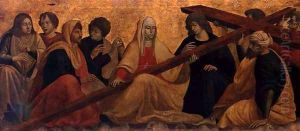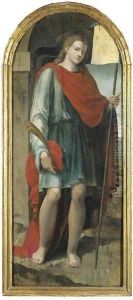(Nicola di Filotesio) Cola dell'Amatrice Paintings
Nicola di Filotesio, known more commonly as Cola dell'Amatrice, was an Italian painter, architect, and sculptor of the Renaissance period, born around 1480 in Amatrice, which was then part of the Kingdom of Naples. His nickname, 'dell'Amatrice', literally means 'from Amatrice,' indicating his place of origin, a small town in the central Italian region now within the province of Rieti, Lazio. He is considered one of the most versatile and talented artists of his time, although today he may not be as widely recognized as some of his contemporaries.
Cola dell'Amatrice began his artistic career in the early 16th century, and his work is characterized by the influence of the Umbrian and Marchigian schools of painting, integrating elements of the Renaissance movement that was flourishing across Italy. He was particularly influenced by the works of Raphael and had connections with other prominent artists of the period. His painting style is noted for its vivid color palette, attention to detail, and the emotional depth of his figures.
Besides painting, Cola dell'Amatrice was also a skilled architect and sculptor. He contributed to the design and construction of several buildings in Ascoli Piceno, where he spent a significant part of his career. Among his architectural contributions is the redesign of the Palazzo dei Capitani del Popolo in the city's main square. His work as a sculptor further demonstrates his versatility and his ability to work across different mediums with great skill.
Unfortunately, a large portion of Cola dell'Amatrice's works was destroyed in the devastating earthquake that struck Amatrice in 2016, leading to a renewed interest in his life and work. Despite this loss, his surviving paintings and architectural designs continue to be studied and admired for their contribution to the Renaissance movement in Italy.
Cola dell'Amatrice died in 1547, leaving behind a legacy that, although overshadowed by some of his contemporaries, is integral to the understanding of Renaissance art and architecture. His works remain a testament to the creativity and innovation of the period, embodying the spirit of exploration and excellence that defined the Renaissance.

